Best On-the-Go Medical Alert Systems IN 2024
Medical alert systems are a crucial part of healthcare technology today, providing an essential lifeline for individuals who may require immediate medical attention. These systems are especially beneficial for seniors, people with disabilities, or anyone with a condition that might necessitate urgent medical assistance.
Brio House is an independent review site. We may earn money when you click links inside our site.
Medical alert systems are a crucial part of healthcare technology today, providing an essential lifeline for individuals who may require immediate medical attention. These systems are especially beneficial for seniors, people with disabilities, or anyone with a condition that might necessitate urgent medical assistance.
A medical alert system is a device that allows the user to call for help in the event of an emergency. These systems come in various forms, including at-home systems and on-the-go wearables, monitored or unmonitored, and traditional or specialized. Some systems include a wearable help button and a base unit, and some have wall-mounted options. They are designed to provide a quick and easy way to summon help in a crisis, whether it’s a medical emergency, a fall, or any other situation where immediate assistance is needed.
The importance of medical alert systems cannot be overstated. For individuals living alone, particularly seniors, these systems offer a sense of security and peace of mind. They know that help is just a button press away, which can be incredibly reassuring for both the individual and their loved ones.
In this article, we will delve into the world of medical alert systems, exploring their features, how they work, and the factors to consider when choosing a system. We will also review the top 9 on-the-go medical alert systems, providing a comprehensive guide to help you make an informed decision. Whether you’re considering a medical alert system for yourself or a loved one, this article aims to provide all the information you need to choose the right system.
Stay tuned as we navigate through the world of medical alert systems, medical alert companies, and the technology that makes these life-saving devices work. We’ll also explore the role of monitoring centers, the importance of automatic fall detection, and much more.
So, let’s embark on this journey to understand better and appreciate the value and functionality of medical alert systems.
What is a Medical Alert System?
A medical alert system is a combination of equipment and a 24/7 monitoring service designed to provide immediate assistance during emergencies. The equipment usually consists of a base unit and wearable devices or wall-mounted sensors. The base unit is typically placed in a central location in your home and connects wirelessly to the wearable devices or sensors.
The wearable devices often come in the form of a lightweight help button that can be worn around your neck as a necklace, on your wrist as a bracelet or watch, on your belt loop, or kept in your pocket. Some systems also offer accessories such as wall-mounted buttons, carrying cases, or extra help buttons.
How do Medical Alert Systems Work?
When the help button on a medical alert system is pressed, a signal is sent to the monitoring center. The monitoring center staff receives your information and location. Some systems offer two-way communication, allowing the monitoring center professional to speak directly to you, evaluate the situation, and assist in getting the appropriate help you need.
After evaluating the situation, the monitoring center staff will dispatch emergency services if they deem it necessary. To ensure uninterrupted monitoring, large medical alert service companies often have two monitoring centers in case of power outages or other issues at one center.
Types of Medical Alert Systems: Home Medical Alert Systems and Mobile Medical Alert Systems
There are two major types of medical alert systems: at-home and on-the-go systems.
At-home medical alert systems are ideal for older adults with chronic diseases or mobility issues, whether living independently or with in-home support. These systems have the base station set up in the home’s central area, with the help button worn around the user’s neck or wrist, or placed at an easy-to-reach location on the wall.
On-the-go medical alert systems, on the other hand, are suitable for both homebound older adults and those who are more active. These systems often include a GPS mobile device that works on the medical alert company’s cellular network. Some mobile systems offer all-in-one devices, and others provide a separate help button you can wear around your neck or wrist, clip to your belt, or carry in your purse or pocket.
Importance of Automatic Fall Detection
Automatic fall detection is a technology built into a medical alert system device to sense when someone has fallen. It uses sensors called accelerometers, which detect motion, to identify when you fall and then send an alert to the medical alert company’s monitoring center that you need help. Most medical alert devices include fall detection as an optional feature for an additional monthly fee.
Role of the Monitoring Center
The monitoring center plays a critical role in any monitored medical alarm system. When you press the emergency button on the base station, wearable help button, or wall-mounted button, you can expect to connect quickly with a trained professional at the monitoring center.
The monitoring center staff member then contacts your local emergency medical services (EMS) and emergency contacts to get help to you as soon as possible. To ensure uninterrupted monitoring, large medical alert service companies often have two monitoring centers in case of power outages or other issues at one center.

Factors to Consider When Choosing a Medical Alert System
Choosing the right medical alert system is a crucial decision that can significantly impact the user’s safety and peace of mind. Here are some factors to consider:
- Home-Based or Mobile System: Originally, medical alert systems were designed to work inside your home with your landline telephone. Many companies now also offer home-based systems that work over a cellular network for those who might not have a landline. Mobile options are also available, which can be used at home and on the go. These operate over cellular networks and incorporate GPS technology for location tracking.
- Monitored or Unmonitored: Monitored systems connect you with a 24/7 dispatching center when the call button is pressed. Unmonitored systems, on the other hand, automatically dial a friend or family member on your programmed emergency call list when the call button is pressed. The choice between monitored and unmonitored systems often comes down to price and personal preference.
- Fall-Detection Feature: Some companies offer the option of automatic fall detection for an additional monthly fee. These devices sense falls when they occur and automatically contact the dispatch center. However, this feature might not work perfectly every time and may register something as a fall that isn’t.
Importance of the Right Medical Alert System
The right medical alert system can provide peace of mind by allowing you to summon help in an emergency. It’s especially beneficial for anyone at risk of falling or having a medical emergency. The right system should be easy to use, reliable, and fit the user’s lifestyle and needs.
Cost of Medical Alert Systems: Per Month, Equipment Fees, and Monthly Costs
The cost of medical alert systems can vary widely depending on the features and services you choose. Here are some cost factors to consider:
- Monthly Fee: This is the ongoing cost for the monitoring service. It can range from around $20 to over $50 per month, depending on the system and features chosen.
- Equipment Fees: Some companies charge a one-time fee for the equipment, while others include the equipment cost in the monthly fee.
- Additional Features: Features like fall detection, GPS tracking, or mobile service can add to the monthly cost.
The Role of Medical Alert Providers and Medical Alert System Companies
Medical alert providers and medical alert system companies play a crucial role in providing these life-saving services. They design and manufacture the equipment, provide the monitoring service, and offer customer support. They may also offer additional services such as medication reminders, check-in calls, and location tracking. It’s important to choose a reputable company with good customer reviews and a history of reliable service.

How do monitored medical alert systems work?
Monitored medical alert systems work by connecting the user to a response center when the help button is pressed. The operator at the center can then assess the situation and contact emergency services if necessary.
What are the Best On-the-Go Medical Alert Systems in 2024?

Reviews: The Top 9 on-the-go Medical Alert Systems in 2024
1. Bay Alarm Medical
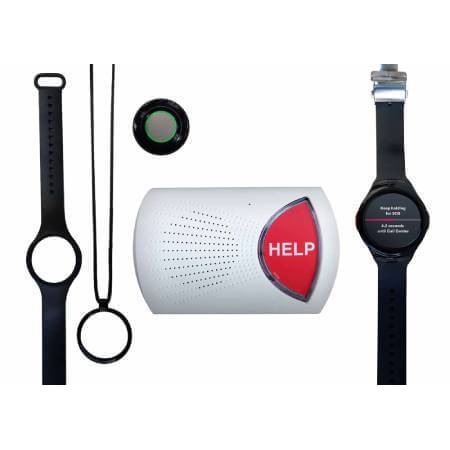
Bay Alarm Medical
Our Rating:

5.0
Bay Alarm Medical is a well-established medical alert company that offers a variety of medical alert systems to cater to different needs. The company is a division of Bay Alarm, a residential and commercial security system provider based in Concord, California. Bay Alarm was founded in 1946 and is still a family-run business.
The medical alert systems provided by Bay Alarm Medical are easy to install, affordable, and backed by a U.S.-based, 24-hour medical alarm emergency call center. They offer in-home systems that connect via landline or cellular connection, a water-resistant mobile system, and an SOS smartwatch that can go nearly anywhere you go.
The on the go medical alert system from Bay Alarm Medical provides coverage when you leave your home. You can either carry the small, lightweight mobile help button or wear Bay Alarm Medical’s SOS smartwatch. The GPS Mobile Help Button costs $29.95 per month with an upfront fee of $99.00, while the SOS Smartwatch costs $34.95 per month with an upfront fee of $159.00.
While automatic fall detection is available with the GPS Mobile Help Button for an added $10.00 per month, fall detection isn’t offered with the SOS Smartwatch. The SOS smartwatch is a unique offering that sets Bay Alarm Medical apart from other medical alert providers. These devices are still relatively new in the industry and Bay Alarm has some of the most affordable models.
Using a U.S.-based monitoring center, Bay Alarm provides assistance 24/7. There are no long-term contracts, and you can try the system risk-free for 30 days. The company states that you can save up to $119.00 per year by bundling in-home and mobile services. On top of that, Bay Alarm does not charge any processing, activation, or programming fees. It offers a 30-day trial period, and will prorate and refund any remaining costs of early canceled plans without charging cancellation fees.
PROS
CONS
Bay Alarm Medical is a reliable medical alert provider that offers a variety of medical alert systems to suit different needs. Their on the go medical alert system is a standout offering, especially with the inclusion of the SOS smartwatch. However, the lack of additional features such as medication reminders and wellness checks, as well as the requirement for equipment fees for on-the-go plans, may be a drawback for some medical alert system users.
Overall, Bay Alarm Medical provides a comprehensive medical alert system that is worth considering for those who need a reliable, easy-to-use system for medical emergencies on the go.
2. Medical Guardian
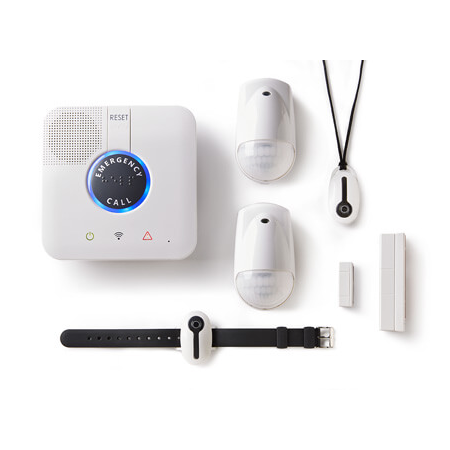
Medical Guardian
Our Rating:

4.6
Medical Guardian is one of the best medical alert systems in the market today, offering a variety of medical alert devices that cater to different needs. Their mobile medical alert system is particularly noteworthy for its versatility and convenience.
The on the go system is designed for active seniors who want to maintain their independence while having the assurance of safety. The mobile device is lightweight and easy to carry around, making it an ideal mobile medical alert device for daily use. It operates on a cellular network, ensuring that you are protected even when you are away from home.
One of the standout features of the Medical Guardian is the automatic fall detection. This feature is designed to detect falls and automatically send an alert to the monitoring center, even if the user is unable to press the emergency call button. This can be a lifesaver in situations where the user is incapacitated due to a fall.
The Medical Guardian also offers GPS location tracking, which can be invaluable in an emergency situation. The monitoring center can use this feature to locate the user and direct emergency responders to their location.
The Medical Guardian also stands out for its customer service. The medical alert company has a team of medical professionals available 24/7 at the monitoring center to assist in any medical emergency.
However, like most medical alert systems, the Medical Guardian comes with a monthly fee. The cost can vary depending on the package chosen, but it is generally competitive with other medical alert companies.
PROS
CONS
The Medical Guardian is a reliable and comprehensive medical alert system that offers a good balance of features and cost. Its on the go system is particularly beneficial for active seniors who want the peace of mind that comes with knowing they can get help whenever and wherever they need it.
3. MobileHelp

MobileHelp
Our Rating:

4.6
MobileHelp is a leading provider in the medical alert system industry, offering a comprehensive solution for both in-home and on-the-go protection. The MobileHelp Complete Protection System (DUO) is designed to provide security and independence for individuals at risk due to advanced age, ongoing medical conditions, or other medical vulnerabilities.
The DUO medical alert system includes a cellular base station for home use and a mobile alert device that can be worn when you’re out and about. The system also includes a charging station for the mobile device and a neck pendant or wrist pendant/fall button, which can automatically detect a fall and alert the monitoring center even if you can’t push the help button.
The DUO system is integrated with nationwide wireless voice, data, and GPS technology, providing real-time medical alert services and GPS location tracking for expedited personal assistance.
The DUO system includes a free combination lockbox to safely store a key outside of your home, allowing emergency services to enter without breaking a window or door if you’re incapacitated. The cost of the DUO at-home and on-the-go protection is $41.95 per month, with an initial fee of $56.
PROS
CONS
MobileHelp offers a comprehensive medical alert system that provides both in-home and on the go protection. However, potential users should be aware of the system’s limitations, particularly in areas with limited AT&T cellular service.
4. Medical Alert
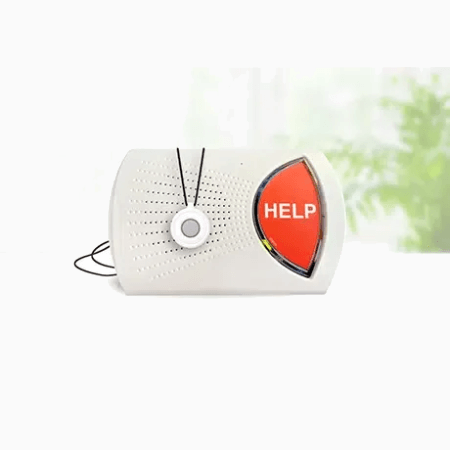
Medical Alert
Our Rating:

4.7
Medical Alert is a brand under Connect America, the largest independent provider of medical alert systems. The company combines reliable technology with simple functions to provide efficient emergency services. They offer both Home and Mobile Systems, which have been tested and found to be high quality and reliable.
The Mobile System is particularly suitable for active older adults. It’s a small mobile device that can be worn like a necklace and contains everything you need – a built-in help button, two-way talk, and GPS location tracking.
The Mobile System has an extended battery life of up to five days. The Mobile System costs $47.95 per month, and you can add fall detection to this system for an additional $10 per month.
PROS
CONS
Medical Alert offers peace of mind and fast access to medical services in the event of a medical emergency. With no hidden fees and plenty of discounts available, Medical Alert is a solid choice for your medical alert system. However, there are other providers with larger, more diverse product lines if you want more options to choose from.
5. ADT

ADT
Our Rating:

4.6
ADT, a well-known name in the home security business, also offers medical alert systems through ADT Health. They serve millions of customers throughout the U.S., including older adults and their caregivers. ADT Health offers at-home and on-the-go medical alert systems.
The on-the-go medical alert system from ADT Health is the most comprehensive safety system in their lineup. It’s great for active seniors who like long jogs or walks around the neighborhood.
The system is wearable, includes GPS location tracking, and isn’t limited by the requirements of a base unit, so you won’t have to worry about going out of range. The mobile device is water-resistant and lasts up to 24 hours after a full three-hour charge on the cradle.
ADT Health’s medical alert systems provide basic-level protection and monitoring. These systems are great for someone in good health who wants some extra reassurance.
PROS
CONS
ADT Health charges between $29.99 per month and $39.99 per month. You can save on monthly costs if you choose the quarterly or yearly plan. Since ADT Health does not require contracts, you can cancel and return the equipment at any time. After you notify them that you’re canceling, they will ship a box for you to pack the equipment in and return it at no extra charge.
ADT is most well-known for its home security systems, but after incorporating their medical alert systems into daily life, they offer adequate alert systems when compared to the other big names in the industry.
6. Alexa Together
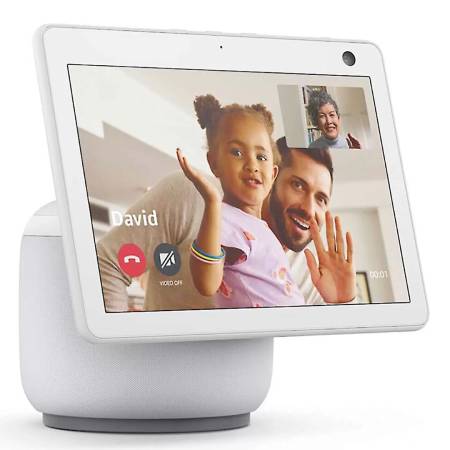
Alexa Together
Our Rating:

4.7
Alexa Together is a subscription service offered by Amazon that augments the features of Alexa-enabled devices to include access to 24/7 urgent response calls, activity tracking, streamlined communication, and fall detection (provided a compatible device is purchased). It’s a unique approach to the medical alert system industry, leveraging the power of smart home technology to provide safety and peace of mind for users and their loved ones.
Unlike traditional medical alert systems that utilize a combination of a base station and wearables, Alexa Together offers a more customized approach. It functions like an app, allowing the primary user to contact emergency monitoring services, receive custom daily alerts, and make use of fall detection (provided a compatible device is available). Secondary users, such as family members or loved ones, can also access this app to track a loved one’s activity, create alerts for them, and initiate video calls (provided a compatible device is purchased).
While most of these features would be available on any Alexa-enabled device, Alexa Together provides the additional functionality of 24/7 monitoring. While Alexa can call 911, only Alexa Together gives you access to a monitoring center. These trained monitoring agents will coordinate a response unique to the user, whether this means contacting emergency responders or a loved one or neighbor for help.
PROS
CONS
Alexa Together is a compelling option for those who primarily stay at home and have a nearby loved one or caregiver. It’s one of the most affordable urgent response services, starting at under $20 per month. However, it’s important to note that its main function is one of connection, helping the primary and secondary users stay in touch throughout the day. If a user doesn’t have a nearby loved one or caregiver, a standalone medical alert system might be a better choice.
For those looking for mobile protection, Alexa Together might not be the best fit as it only provides service in the home. Also, while Amazon states that Alexa Together will soon support multiple caregivers, this functionality is currently confined to one.
Alexa Together is a unique and innovative approach to medical alert systems, leveraging the power of smart home technology to provide safety and peace of mind for users and their loved ones. However, it’s not a one-size-fits-all solution and may not be the right medical alert system for everyone, particularly those who require mobile medical alert systems or have multiple caregivers.
7. LifeFone
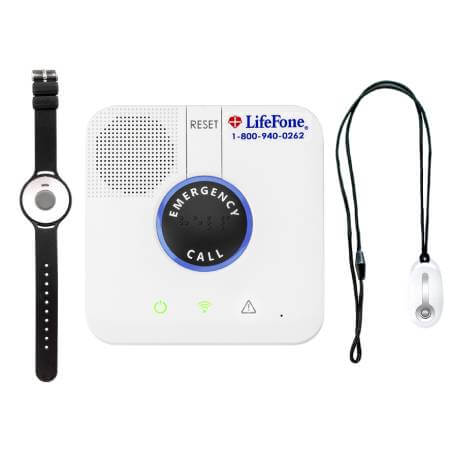
LifeFone
Our Rating:

4.7
LifeFone has been in the medical alert business since 1976 and has thousands of customers across the country. The company’s products have evolved considerably over the last 40 years, offering GPS options that run on cellular networks for more flexibility. For this review, the LifeFone’s cellular At-Home & On-the-Go package with fall detection was tested.
LifeFone is recognized by many leaders in senior health, including the National Council on Aging and the American Stroke Association. The products are approved for usability, price, and transparency (no hidden fees here).
PROS
CONS
LifeFone offers seniors a variety of affordable options for medical alert systems. Plus, with a lifetime price guarantee, you can rest easy knowing that your monthly payments will never go up. However, if you want a lot of extra bells and whistles with your medical alert device, you may end up spending more than you bargained for with LifeFone.
The LifeFone’s At-Home & On-the-Go system came in a small box with everything included. Inside was the base station, a wall plug, a help wristband, a waterproof pendant (with the fall detection option), a mobile device with a charging cradle, and an instruction manual. The setup was straightforward and quick.
LifeFone systems have a lifetime warranty, and all of the equipment is covered for normal wear and tear and includes battery replacements at no additional cost. This warranty is solid; some other medical alert companies we’ve reviewed, like Lifeline, only offer a one-year warranty for select systems.
LifeFone offers a ton of add-on services and accessories, including Activity Assurance caregiver tool, Family Guard app, fall detection, daily check-in calls, medication reminders, location services, Protection Plan, VIPx Caregiver App, Mobile Alert App, and more.
LifeFone is a solid choice for a medical alert device. The company’s systems offer the essential features you need to stay protected, including fall detection, wide coverage ranges, 24/7 monitoring, and caregiver tools. With lifetime warranties, no upfront costs or activation fees, and seasonal discounts, there is an option for most budgets. You’ll also have a 30-day money-back guarantee, which is appreciated. While there are some higher-tech systems on the market, LifeFone is still an excellent option.
8. Lively Mobile Plus
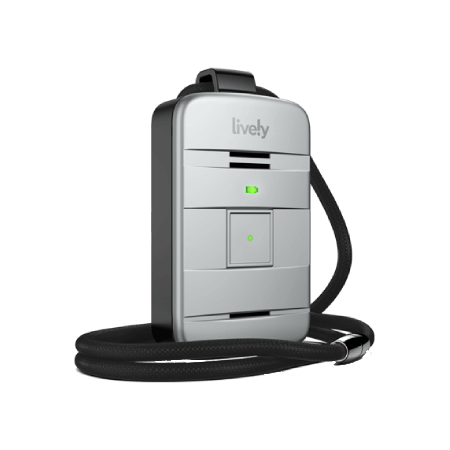
Lively Mobile Plus
Our Rating:

4.6
Lively Mobile Plus is an all-in-one medical alert system that aims to provide safety and peace of mind for its users. This mobile medical alert system is designed to be worn on the person, eliminating the need for a base station or additional equipment. It is equipped with two-way communication capabilities and enhanced GPS accuracy for precise, real-time location tracking.
The device can be purchased either on the Lively website or from several other online and brick-and-mortar stores. Lively offers users three pricing tiers for their monthly monitoring billing options. The basic package costs $24.99 for emergency response only, the preferred package costs $29.99 and includes a link to a family member, and the ultimate package costs $39.99 and includes urgent care and fall detection.
PROS
CONS
The Lively Mobile Plus medical alert system is a solid option for anyone looking to improve their safety while living an independent life both inside and outside the home. However, the performance of the automatic fall detection feature could be improved, and nightly charging could pose an issue for users who are likely to forget to put it back on each morning. Meanwhile, it’s a plus to be able to wear the device in the shower without impacting its functionality.
9. Aloe Care Health
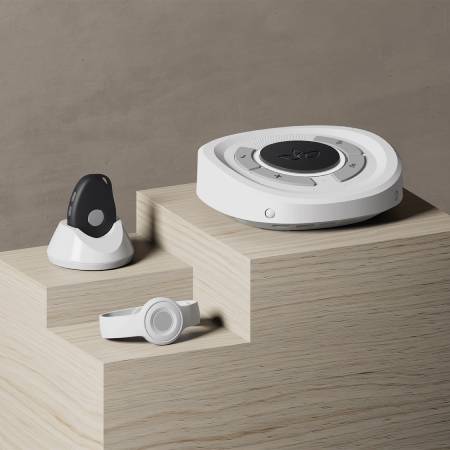
Aloe Care Health
Our Rating:

4.7
Aloe Care Health, based in New York, is a medical alert company that launched its advanced medical alert and communication service for eldercare in 2018. The company offers a comprehensive medical alert system that not only provides emergency alert capabilities but also includes features such as automatic fall detection, room sensors, two-way communication, and a collaborative care app.
The medical alert system from Aloe Care Health comes in four different packages. The mid-tier option, known as Essentials Plus, includes an additional wearable device called the Mobile Companion Go. This mobile medical alert device has 4G capabilities, allowing users to continue to benefit from the service when outside the home. The most comprehensive package, Total Care, also includes a motion sensor that can be placed in the home to monitor for any unusual activity or falls.
The Mobile Companion Go is a small device designed to provide coverage on the go. It can be worn around the neck inside or outside the home, and features automatic fall detection, two-way calling to the emergency response center, GPS and 4G LTE so caregivers can view the user’s location.
The medical alert system works by providing an extra layer of support for adults with physical or cognitive limitations living at home, especially those at a high fall risk. It’s designed to alert caregivers or emergency personnel in the case of an emergency, like a fall or medical situation.
PROS
CONS
Overall, Aloe Care Health’s on the go medical alert system is a comprehensive solution that offers a range of features to support older adults living at home. It provides an extra layer of security and peace of mind for both the user and their caregivers.
Importance of GPS tracking and location tracking in mobile medical alert systems
The importance of GPS tracking and location tracking in mobile medical alert systems cannot be overstated. These features are critical for the safety and well-being of the user, especially in emergency situations. Here’s why:
- Immediate Location Identification: In an emergency, every second counts. GPS and location tracking allow the monitoring center to quickly identify the user’s location and dispatch emergency services promptly. This is particularly crucial if the user is unable to communicate their location due to a medical emergency.
- Mobility and Independence: Mobile medical alert systems with GPS tracking provide users with the freedom to move around, whether they’re at home, running errands, or traveling. Users can feel confident knowing that help is just a button press away, no matter where they are.
- Peace of Mind for Family Members: For family members and caregivers, knowing that their loved one’s location can be quickly and accurately determined in an emergency provides invaluable peace of mind. Some systems even offer features like geofencing, which alerts caregivers if the user leaves a predefined area.
- Fall Detection and Automatic Alerts: Some mobile medical alert devices come with automatic fall detection. If a fall is detected, the device can automatically send an alert to the monitoring center, even if the user is unable to press the emergency button. The GPS location tracking feature can then be used to send help to the right location.
- Useful for Dementia or Alzheimer’s Patients: For individuals with dementia or Alzheimer’s who may wander and become disoriented, a mobile medical alert system with GPS tracking can be a lifesaver. If the individual becomes lost or confused, the GPS tracking feature can help locate them quickly.
GPS and location tracking are essential features in mobile medical alert systems. They enhance the effectiveness of the system, provide peace of mind for users and their families, and most importantly, they can save lives in emergency situations.
FAQs on Medical Alert Systems
What is a personal emergency response system?
A personal emergency response system (PERS) is a device that allows individuals to call for help in an emergency situation. It usually consists of a wearable help button and a base unit that connects to a response center.
What is a monitored medical alert system?
A monitored medical alert system is a type of personal emergency response system that is connected to a 24/7 monitoring center. When the help button is pressed, the system immediately contacts the monitoring center, and a trained operator responds to the call.
How do monitored medical alert systems work?
Monitored medical alert systems work by connecting the user to a response center when the help button is pressed. The operator at the center can then assess the situation and contact emergency services if necessary.
What are the benefits of personal emergency response systems?
Personal emergency response systems provide peace of mind for users and their families, knowing that help is just a button press away. They are especially beneficial for seniors living alone, people with medical conditions, or those recovering from surgery.
How does a medical alert system contact emergency services?
When the help button on a medical alert system is pressed, it sends a signal to a monitoring center. The operator at the center can then contact emergency services on behalf of the user.
What is a price lock guarantee in medical alert systems?
A price lock guarantee ensures that the monthly cost of your medical alert system will not increase over time. It provides financial predictability for users.
What is an in-home system in the context of medical alert systems?
An in-home system refers to a medical alert system designed to work within the user’s home. It usually consists of a base unit and a wearable help button.
What is a fall detection device in a medical alert system?
A fall detection device is a feature in some medical alert systems that automatically sends an alert to the monitoring center if it detects a fall.
Who are the most reputable medical alert companies?
Some of the most reputable medical alert companies include Life Alert, Medical Guardian, Bay Alarm Medical, and Philips Lifeline, among others.
What are the top medical alert systems on the market?
The top medical alert systems on the market vary depending on specific needs, but some highly rated systems include those from companies like LifeFone, MobileHelp, and ADT.
Who are the providers of medical alert systems?
Medical alert system providers are companies that manufacture and supply medical alert devices. These include companies like Life Alert, Medical Guardian, and Bay Alarm Medical.
Who are the typical users of medical alert systems?
The typical users of medical alert systems are seniors, people with serious medical conditions, those recovering from surgery, or anyone who might need immediate medical assistance.
How much do medical alert systems cost?
The cost of medical alert systems can vary widely depending on the features and level of service. Monthly fees can range from around $20 to over $50.
What are medical alert system packages?
Medical alert system packages refer to the different service plans offered by medical alert companies. These can include various features such as fall detection, GPS tracking, and mobile alert systems.
What is a GPS medical alert system?
A GPS medical alert system is a type of medical alert device that uses GPS technology to track the user’s location. This is especially useful for users who are often out of their homes.
Where can I find a medical alert system FAQ?
Most medical alert companies provide a FAQ section on their websites where youcan find detailed information about their products and services.
What does it mean to cover medical alert systems?
To cover medical alert systems means that a certain cost associated with the system, such as the purchase cost or monthly fees, is paid for by another party. This could be an insurance company, a government program, or a family member.
What is a cellular system in the context of medical alert systems?
A cellular system in the context of medical alert systems refers to a system that uses a cellular network to connect the user to the monitoring center. This type of system does not require a landline and can work anywhere with cellular coverage.
What are the monthly fees for medical alert systems?
Monthly fees for medical alert systems vary depending on the provider and the package chosen. They typically range from around $20 to over $50 per month. These fees usually cover the use of the equipment and 24/7 monitoring services.
The Role of Medical Professionals in Medical Alert Systems
Medical professionals and emergency responders play a crucial role in the effectiveness of medical alert systems. Here’s how they interact with these systems and why their role is so important:
- Immediate Response to Emergencies: When a user presses the emergency button on their medical alert device, the signal is sent to a monitoring center. The operators at the center, who are often trained medical professionals, assess the situation and immediately contact the appropriate emergency services. This could be an ambulance, the fire department, or the police, depending on the nature of the emergency.
- Providing Crucial Medical Information: Medical professionals can provide vital information to emergency responders in the event of a medical emergency. For instance, they can relay important information such as the user’s medical history, medications, preferred hospital, or conditions that may interact negatively with EMT treatments. This information can be crucial in ensuring the user receives the right care as quickly as possible.
- Monitoring Health Status: Some medical alert systems come with features that allow for continuous health monitoring. These features can monitor vital signs, detect falls, and even predict potential health issues. The data collected can be accessed by medical professionals who can then take the necessary actions or provide advice to the user.
- Non-Emergency Assistance: Not all situations are emergencies, but users may still need assistance. Medical professionals can provide non-emergency assistance through the medical alert system. For instance, if a user feels unwell but it’s not an emergency, they can press the help button and get connected to a medical professional who can provide advice or reassurance.
- Role of Emergency Responders: Emergency responders are the ones who arrive at the scene when a user presses their emergency call button. They are trained to handle a wide range of emergencies and can provide immediate medical assistance. Their quick response can make a significant difference in the outcome of a medical emergency.
Medical professionals and emergency responders are integral to the functioning of medical alert systems. They ensure that users receive immediate assistance in emergencies, provide crucial medical information, monitor users’ health status, and even provide non-emergency assistance. Their role enhances the effectiveness of these systems and provides peace of mind to users and their families.
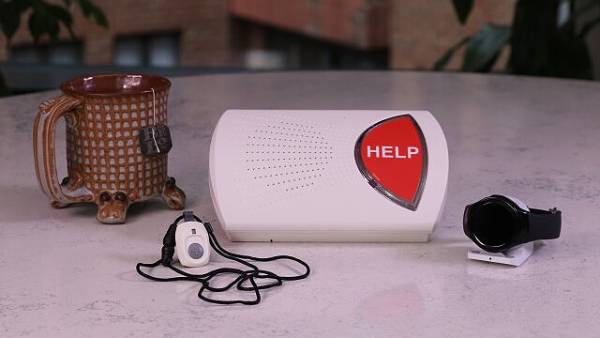
The Role of Technology in Medical Alert Systems
Technology plays a significant role in the functionality and effectiveness of medical alert systems. Here’s how mobile devices, mobile systems, and cellular networks contribute to these systems:
- Mobile Devices and Mobile Systems: Mobile devices and mobile systems have revolutionized the way medical alert systems work. They have made it possible for users to have access to help no matter where they are. With a mobile medical alert device, users can press a button to get help whether they’re at home, at the grocery store, or out for a walk. Some mobile devices even come with GPS location tracking capabilities, which can be crucial in an emergency when the user is unable to communicate their location.
- Cellular Network and Cellular Connection: Cellular networks are crucial for mobile medical alert systems. When a user presses the emergency button on their mobile device, the signal is sent via a cellular network to a monitoring center. This means that as long as the user is in an area with cellular coverage, they can get help when they need it. This is particularly important for on-the-go medical alert systems, which are designed to work outside the home.
- GPS Tracking: GPS tracking is another important technological feature in medical alert systems. It allows the monitoring center to pinpoint the user’s location in the event of an emergency. This can be particularly useful if the user is disoriented, unconscious, or otherwise unable to communicate their location.
- Automatic Fall Detection: Some medical alert devices come with automatic fall detection technology. This feature can detect if the user has taken a fall and automatically send a signal to the monitoring center. This can be a lifesaver in situations where the user is unable to press the emergency button themselves.
Technology plays a crucial role in medical alert systems. It enables these systems to provide immediate assistance in emergencies, track the user’s location, and even detect falls. As technology continues to advance, we can expect to see even more innovative features in medical alert systems in the future.
The Role of Family in Medical Alert Systems
- How family members can help in the selection and use of medical alert systems
- Family members often play a crucial role in the selection of a medical alert system. They can assist in researching various medical alert companies and comparing the features, costs, and reviews of different systems.
- They can also help in understanding the specific needs and preferences of the user, such as whether a home medical alert system or a mobile medical alert system would be more suitable.
- Family members can participate in the setup and testing of the system, ensuring that it works properly and that the user knows how to use it.
- They can also be listed as contacts in the system, to be notified in case of an emergency.
- Importance of emergency call buttons for family members
- Emergency call buttons are a key feature of medical alert systems. They allow the user to immediately signal for help in case of a medical emergency, fall, or other urgent situation.
- For family members, knowing that their loved one has immediate access to help can provide peace of mind.
- Some systems also allow family members to be notified if the emergency call button is pressed, keeping them informed and allowing them to respond quickly if needed.
The Future of Medical Alert Systems
The future of medical alert systems is promising, with technology advancements and changing needs of active older adults driving innovation. Here are some emerging trends and future directions in medical alert systems:
- Increased Health and Activity of Seniors: The Boomer generation is proving that aging doesn’t have to slow a person down. As such, medical alert system designers are changing products to match those lifestyle choices. Longer battery life, GPS and WiFi connection, and fall detection technology are all being incorporated to ensure older adults can get assistance no matter where they are or what they’re doing.
- Enhanced Communication: Future medical alert systems are likely to offer enhanced communication features. For example, some systems may allow seniors to designate people who can access their daily information. These caregivers can see if there was a fall or call for help via an app or on their desktop. This enhanced communication can help family members advocate for their loved ones from miles away.
- Affordability: With many seniors living on a fixed budget, costs for any device must not be prohibitive. Companies are focusing on creating new ways to make devices and technology affordable so that every senior can enjoy the protection and peace of mind medical alert systems offer.
- Beating Stereotypes: There’s a stigma that using a medical alert system is a sign of weakness or frailty. Companies are fighting this stigma by innovating new designs that are even more discreet and fashionable. The goal is to show older adults the benefits of medical alert technology and emphasize that a medical alert system actually enhances the independence of the person using it.
- Innovative Features: As technology continues to advance, we can expect to see even more innovative features in medical alert systems. For example, we might see systems that can monitor vital signs or detect health problems before they become serious. There might also be advancements in AI technology, allowing systems to learn from the user’s behavior and predict potential emergencies.
The future of medical alert systems is bright. As technology continues to advance and the needs of seniors continue to evolve, we can expect to see medical alert systems that are more advanced, more user-friendly, and more effective than ever before.
The Bottomline:
In this comprehensive guide, we’ve explored the world of medical alert systems, focusing particularly on the on-the-go medical alert systems. We’ve delved into what medical alert systems are, how they work, and the crucial role they play in providing immediate assistance in emergencies. We’ve also looked at the factors to consider when choosing a system, including cost, features, and the reputation of the medical alert company.
We’ve reviewed nine of the top on-the-go medical alert systems on the market, highlighting their features, pros, and cons. We’ve also compared these systems, emphasizing the importance of GPS tracking and location tracking in mobile medical alert systems.
We’ve answered some common questions about medical alert systems and discussed the role of medical professionals and emergency responders in these systems. We’ve also looked at the role of technology, particularly mobile devices and cellular networks, in medical alert systems.
Family members play a crucial role in the selection and use of medical alert systems, and we’ve discussed how they can help and the importance of emergency call buttons for family members. We’ve also looked at the future of medical alert systems, discussing emerging trends and future directions.
Medical alert systems are a crucial tool for seniors and people with medical conditions who value their independence. They provide a lifeline in emergencies, giving users and their families peace of mind. When choosing a medical alert system, it’s important to consider the user’s lifestyle, needs, and preferences, as well as the features and costs of different systems. With the right system, users can continue to live their lives to the fullest, knowing that help is just a button press away.
